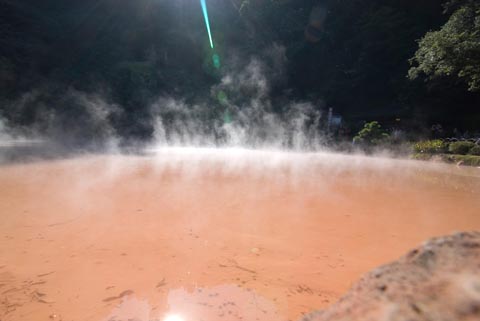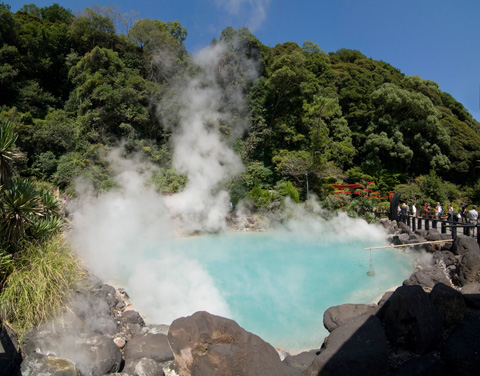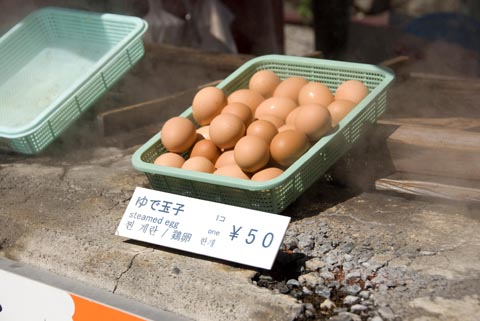
Takegawara Onsen, Beppu
We headed off to Beppu on the Sonic limited express train. The hotel had a nice outdoor onsen on the rooftop so we could enjoy the view of the stars and the hot bath. In the morning we checked out of our hotel and walked along the shore (which was lined with giant concrete erosion control “jacks”) before walking to Takegawara Onsen. Takegawara is a historic onsen that dates back to 1879. There we took a sand bath: you dress in a cotton yukata, lay down in the hot sand, and the bath attendants bury you up to your chin in steaming hot sand. You lay under the sand until you feel just a little bit cooked and just a little bit crushed, before they tell you to wriggle out of the sand and rinse off in the bath. Unfortunately by the time my “bath” was finished, the morning sun was shining right in my eyes, so I had to close them. The feeling is uniquely oppressive yet refreshing.
After the bath we hopped on a bus to see some of Beppu’s famed jigoku (“hells”). The first one we arrived at was Hon-bozu Jigoku (Real Monk’s Hell), which is managed independently of the other hells. The jigoku is named for the hot bubbling mud that resembles a monk’s shaven head, and the historical handout that we got said that when the geyser first opened up during an earthquake there was a monastery on the site and the monk was tossed into the air by the hot steam (I hope that part is just a legend). In any case, the muddy hills were pretty cool to look at so I would definitely recommend this jigoku.
There was also a spot where volcanic gases vented out from under a rock. Lots of people have left their coins here and the 5 and 10 yen coins turn an impressive shade of violet.
Next we walked downhill to Umi jigoku (Sea Hell). This hell was very popular but also very beautiful. The water is a beautiful aqua shade. There are some torii that lead to a small shrine. Onsen tamago in a basket suspended from a bamboo pole cook in the main pond.

onsen tamago
In addition to the main pond there is a large, emerald green pond. In the pond you can see lotus flowers and giant lily pads which are apparently large enough to float small children on.

Umi Jigoku’s Chinoike
There is also a mini Chinoike (Blood Pond) there. Although it was small, on that day this Chinoike was much more impressive than the real thing.

the real Chinoike
Unfortunately, it was really sunny that day so the jigoku were not at their photogenic best. The steam rising from the ponds was a little thin and a lot of them were just plain old boring. I’d say that Umi Jigoku was the best value and Hon-bozu Jigoku was pretty interesting. Bozu Jigoku, next to Umi Jigoku, was a huge disappointment and hardly seemed worth the 400 yen entrance fee. Shiraike Jigoku was just ok, but might be better on a cooler day. Chinoike Jigoku seems to have potential, but was pretty boring on a sunny day.
Of course our day in Beppu wasn’t all hells an photo-taking. We also stopped to enjoy some snacks. I wanted to try the onsen tamago at Umi Jigoku, but unfortunately they’re sold 5 at a time. I didn’t really want to eat 5 boiled eggs so we had some ice cream and an onsen steamed custard (it was just ok). Outside of Shiraike Jigoku, some vendors were selling eggs cooked with onsen steam by the piece, so we bought some. They were much firmer than the onsen tamago that I’m used to (I suppose that makes sense, steam is hotter than most onsen water) and pretty bouncy (well done). I suppose in the end it’s just a novelty, but it was a pretty tasty snack. We also found a shop selling moromi soft serve. Moromi is a kind of chunky, whole-grained relative of miso that is often used as a vegetable dip. It’s a little sweet and tastes a lot like miso. So how was moromi soft serve? Pretty good, actually.





